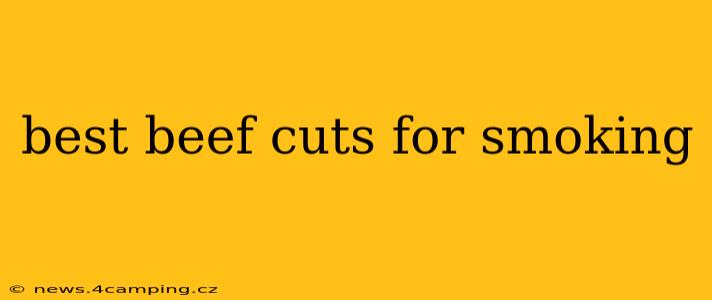Smoking beef is a culinary journey that rewards patience and precision with intensely flavorful results. But not all beef cuts are created equal when it comes to smoking. Some cuts are naturally more tender and flavorful, making them ideal candidates for low-and-slow smoking, while others might be better suited for different cooking methods. This guide explores the best beef cuts for smoking, helping you choose the perfect cut for your next barbecue adventure.
What Makes a Cut Ideal for Smoking?
Before diving into specific cuts, let's understand what characteristics make a cut ideal for smoking. Smoking, particularly low-and-slow smoking, is all about breaking down tough connective tissues. Cuts with more connective tissue (collagen) benefit the most from this process, transforming them from tough to incredibly tender and juicy. Cuts with generous marbling (intramuscular fat) also contribute to incredible flavor and moisture.
Top Beef Cuts for Smoking
Several cuts stand out as exceptional choices for smoking, each offering a unique flavor profile and texture:
1. Brisket: The King of Smoked Beef
The brisket, undeniably the king of smoked meats, is a large cut from the cow's chest. Its tough connective tissue breaks down beautifully during a long, low-and-slow smoke, resulting in melt-in-your-mouth tenderness. The rich, smoky flavor permeates the meat, creating a truly unforgettable experience. Choose a packer brisket (larger, more fat) or a flat (leaner) depending on your preference for fat content.
2. Chuck Roast: A Budget-Friendly Favorite
The chuck roast, a less expensive cut from the shoulder, is another excellent choice for smoking. It's incredibly flavorful and, like the brisket, benefits tremendously from the low-and-slow smoking process. The long cooking time breaks down the tough connective tissue, resulting in a remarkably tender and juicy final product.
3. Short Ribs: Bone-In Beef Delight
Short ribs, with their rich marbling and generous bone-in structure, are a true indulgence. Smoking short ribs renders the fat, resulting in incredibly flavorful, tender, and fall-off-the-bone meat. They are a bit more expensive, but the results justify the price.
4. Ribeye: A Marbled Masterpiece (for shorter smokes)
While typically known for grilling, a ribeye steak or roast can also be smoked, especially using a higher temperature for a shorter time. The abundant marbling provides incredible flavor and ensures a juicy result. A reverse sear technique (smoking low then searing hot) works wonders for ribeyes.
5. Tri-Tip: A Versatile Choice
The tri-tip, a triangular cut from the bottom sirloin, is a versatile cut well-suited for smoking. It offers a leaner option compared to brisket or chuck roast but still delivers fantastic flavor when smoked properly. Its smaller size also means a quicker smoke time than some other cuts.
Frequently Asked Questions (FAQs)
Here are some commonly asked questions about smoking beef:
What is the best wood for smoking beef?
Several woods pair well with beef, including hickory, mesquite, oak, and pecan. Hickory offers a strong smoky flavor, while oak provides a more subtle taste. Mesquite can be quite strong, so use it sparingly. Experiment to find your preferred wood.
How long does it take to smoke beef?
The smoking time varies greatly depending on the cut and the size. A brisket can take 12-18 hours or even longer, while a tri-tip might only require 4-6 hours. Use a meat thermometer to ensure the beef reaches the desired internal temperature.
What temperature should I smoke beef at?
The ideal temperature for smoking beef is generally between 225°F and 250°F (107°C and 121°C). Maintaining a consistent temperature is crucial for even cooking.
How do I know when my smoked beef is done?
Use a meat thermometer to check the internal temperature. Brisket is typically done at 200-205°F (93-96°C), while other cuts may have slightly different target temperatures. Look for tenderness—it should easily pull apart.
Can I smoke beef from frozen?
It's generally not recommended to smoke beef from frozen. The uneven thawing can lead to uneven cooking and potentially unsafe food. Thaw the beef completely before smoking.
By choosing the right cut and employing proper smoking techniques, you can unlock the incredible potential of smoked beef. Experiment with different cuts and woods to discover your favorites and create your signature smoked beef masterpiece.
